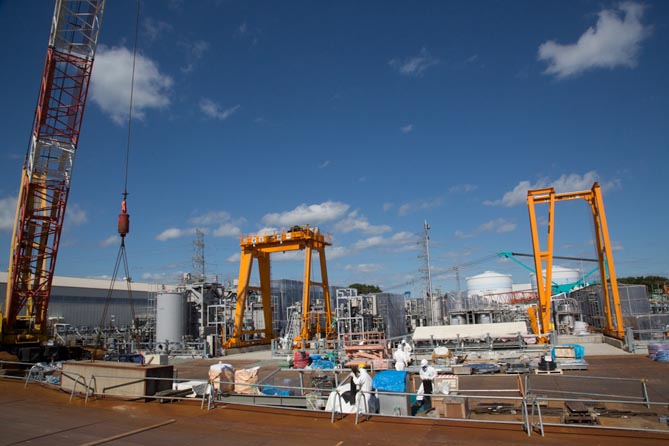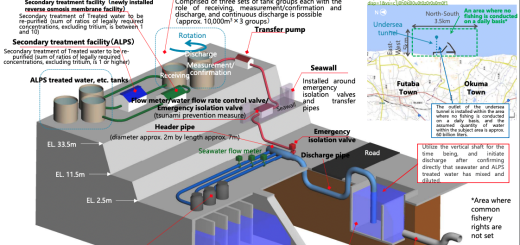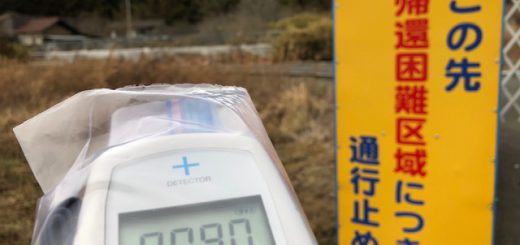Fukushima Daiichi Nuclear Power Station Accident – Two Years On Nuke Info Tokyo No. 153
 |
|
Construction of a new water processing plant ‘ALPS’ at the Fukushima Daiichi Nuclear Power Station, October 2012.
(cc) OZAKI TAKASHI |
It is now two years since the Great East Japan Earthquake disaster and the Tokyo Electric Power Company (TEPCO) Fukushima Daiichi Nuclear Power Station accident.
Restoration and reconstruction in the disaster-stricken areas has not been easy. Although it was anticipated from the start, restoration work has been especially hard in Fukushima. This is because it is impossible to find an effective way of dealing with the radioactive contamination. Not only Fukushima Prefecture, but all the areas that are suffering from radioactive contamination share the problem of the uncertain future of the children. The mayor of Futaba Town, which moved en masse to Saitama Prefecture after the accident, resigned on February 12, 2013 after stating that it would be 30 years before the people could returno their hometown. It is thought that the mayor intended to say that if the whole town could wait 30 years then the contamination would fall to half of what it had originally been, since 30 years is the half-life of Cesium-137. That notion, however, was not acceptable to the people of the town. The population has been severed from its town and the people have become divided amongst themselves.
The fear of radiation has brought about the existence of large numbers of families leading a double life, with the breadwinner remaining in Fukushima and the rest of the family evacuating to another prefecture. The people’s hearts and the bonds between them have been sundered, and there is no sign that they will ever be able to return to the tranquillity of life they enjoyed before the disaster.
Large numbers of children are now living in areas where radiation levels are about the same as those applied as the criteria for compulsory relocation or right-of-evacuation areas at the time of the Chernobyl catastrophe. In June 2012, the Nuclear Accident Child Victims’ Law was enacted, but this has not resulted in any concrete developments. Of 38,114 children surveyed thus far, three have been diagnosed with thyroid cancer and a further seven are suspected. On whether this frequency of occurrence of the cancer is high or not, it is reported that Shunichi Yamashita, chairman of the study committee of the Fukushima Health Management Survey, stated that “there is no comparative data.” He seems to imply a denial of a connection with the nuclear accident, but considering the circumstances at the time of the accident and the subsequent daily lifestyle and evacuation, this does nothing to allay the fears of the parents.
We hear the cries of the farmers. The degree of contamination differs for each rice field or upland field, and even within each field. Although a detailed contamination map of all farmland should have been made at an early stage, this work has still not been carried out. The current two-kilometer square grid is far too large and this should be reduced at least to a 100-meter square grid, but it is doubtful that contamination would be uniform within that area. Unless a clear picture of the amounts and degree of dispersal of radioactive materials can be built up, ambiguities about the contamination of agricultural products will always remain.
The anxieties of fishermen are still continuing. The situation concerning the contamination of fish is not at all clear. There are voices that proclaim there is nothing to worry about, but the range and degree to which the sea has been contaminated by the nuclear accident is unknown. It is impossible to have confidence about eating seafood. The accident has turned out to be deeply criminal.
It is impossible to forget that this awful state of affairs was caused by a nuclear power plant, which is supposed to represent the peaceful use of atomic energy.
Public comments for nuclear power plant safety criteria
The five members of the Nuclear Regulatory Authority (NRA) were finally approved by the Diet on February 15. Prime Minister Noda of the previous government appointed the members by use of a special measure, but was unable to gain approval from the Diet. This was because the Declaration of Nuclear Emergency, the ground for the special measure, has not yet been lifted. As the NRA was actually established on September 16, 2012, it has taken five months to transform it into an official body.
In just the past year, the Nuclear Safety Commission and the Nuclear and Industrial Safety Agency have been abolished and the term of the members of the Japan Atomic Energy Commission (AEC) ended on 5 January 2013. Whether or not the AEC will continue to exist has not yet been decided, but it is thought that its historical mission has ended. The Nuclear Policy Planning Council has also been suspended, as have the Ministry of Economy, Trade and Industry Fundamental Issues Committee and the government’s Energy and Environment Council.
As a result of the change in government, the official move toward a nuclear phase-out that began on March 11 two years ago has come to a halt. Prime Minister Abe has begun to speak in terms of reviewing the “zero nuclear” policy. This is an outcome of the House of Representatives election in December 2012. In a political situation such as this, the independence of the NRA will be further called into doubt. For a long time we have believed that with three of the five members being residents of the “nuclear village,” and four out of the six members of the study team on the new safety standards for nuclear power plants having clear conflicts of interests, it would be impossible to have confidence in the work of the NRA. The fundamental question that remains is how is it possible to formulate new safety standards while what exactly happened in the Fukushima nuclear power plant accident is still not fully understood?
Our fears have been realized in actuality. An event that shows that the “nuclear village” is still as ever “alive and well” came to light on February 1, 2013. A high official close to the top leadership of the NRA had had eight personal meetings with the Japan Atomic Power Company and had handed over the result of the subsurface fault investigation at Tsuruga Nuclear Power Station before the study team’s formal study meeting was held. It was reported in the media that opinions among the NRA members were split, with some expressing regret while others said it was no big deal.
The draft outline of new nuclear power plant safety standards, to be finalized in July, was produced and public comments were solicited from the people with a February 28 deadline. The stance of the NRA Chairman Shunichi Tanaka is that the pros and cons of reactor restarts will be judged in accordance with these safety standards, which concern both nuclear reactor facilities and the problems of earthquakes and tsunamis. The deadline for comments on the disaster measures for nuclear power plants passed on 12 February 2013, with 3,155 public comments having been received.
TEPCO deceit uncovered
Four different reports have been published on the Fukushima nuclear accident. Of these, only the Report of the National Diet of Japan Fukushima Nuclear Accident Independent Investigation Commission (NAIIC) claims that the earthquake was probably the primary cause of the Fukushima nuclear accident. This analysis was the conclusion of the study by commissioners Katsuhiko Ishibashi, Mitsuhiko Tanaka and their research team.
The report conservatively states that “We believe there is a possibility that the earthquake damaged equipment necessary for ensuring safety, and that there is also a possibility that a small-scale LOCA occured in Unit 1. We hope these points will be examined further by a third party.” While not making definitive assertions about the effect of the earthquake on the reactors at Fukushima Daiichi, the report is exceedingly persuasive on this matter.
NAIIC commissioner Tanaka reasoned very soon after the accident that the loss of coolant resulting in the reactor core meltdown in Unit 1 was probably due to the earthquake. The soundness of the isolation condenser (IC) is in doubt. He was determined to go inside Unit 1 in March 2012 in order to check the IC, but it has now become clear that he was lied to by TEPCO in order to force him to abandon the attempt (Asahi Shimbun, February 7, 2013). He was told by TEPCO that the inside of the building was pitch dark, that they did not know where or in what way wreckage was strewn about, that they did not know where there were holes in the walkway, that objects might fall from overhead, that they could not guide him in, that radiation levels were high, and that he would have to provide his own protective suit and headlamp. The explanation of TEPCO president Naoki Hirose, who was summoned as a witness to the House of Representatives Budget Committee on February 12, that this had not been done deliberately is one that cannot be trusted. The predisposition of TEPCO to forge data and hide anything inconvenient has not changed since the 2002 incident in which they covered up troubles at nuclear power plants.
Take back the sovereignty of residents and citizens!
The election of December 2012 tolled the death knell for the will of the sovereign people toward a nuclear phase-out and the Liberal Democtratic Party (LDP), which is pro-nuclear, won an overwhelming victory with over 60% of the seats. This has a deep connection with the current election system. The proportion of the total number of eligible voters who voted for the LDP was 24.6% in the constituencies and 16.0% in the proportional representation poll. In spite of this, the number of seats gained by the LDP was 237 (79.0%) in the single-seat constituencies and 57 (31.7%) in the proportional representation poll. The Tokyo Shimbun evaluated the election in these terms: “The LDP victory does not necessarily reflect the will of the people. It is quite clear that the large number of new parties participating in the election and the low voter turnout worked to the advantage of the LPD.”
When one considers the grave state of affairs in Fukushima, none of the nuclear power plants on the Japanese archipelago can exist in safety, just as Fukushima’s did not. The mantra of the “nuclear village” that “nuclear power plants are safe and cheap” has been completely destroyed by the Fukushima accident and Kenichi Oshima’s research. Oshima’s “The Cost of Nuclear Power – The Viewpoint of Energy Transformation” (Iwanami Shinsho) was awarded the 12th Osaragi Jiro Rondan Prize (for 2012).
Yukio Yamaguchi (Co-Director of CNIC)


